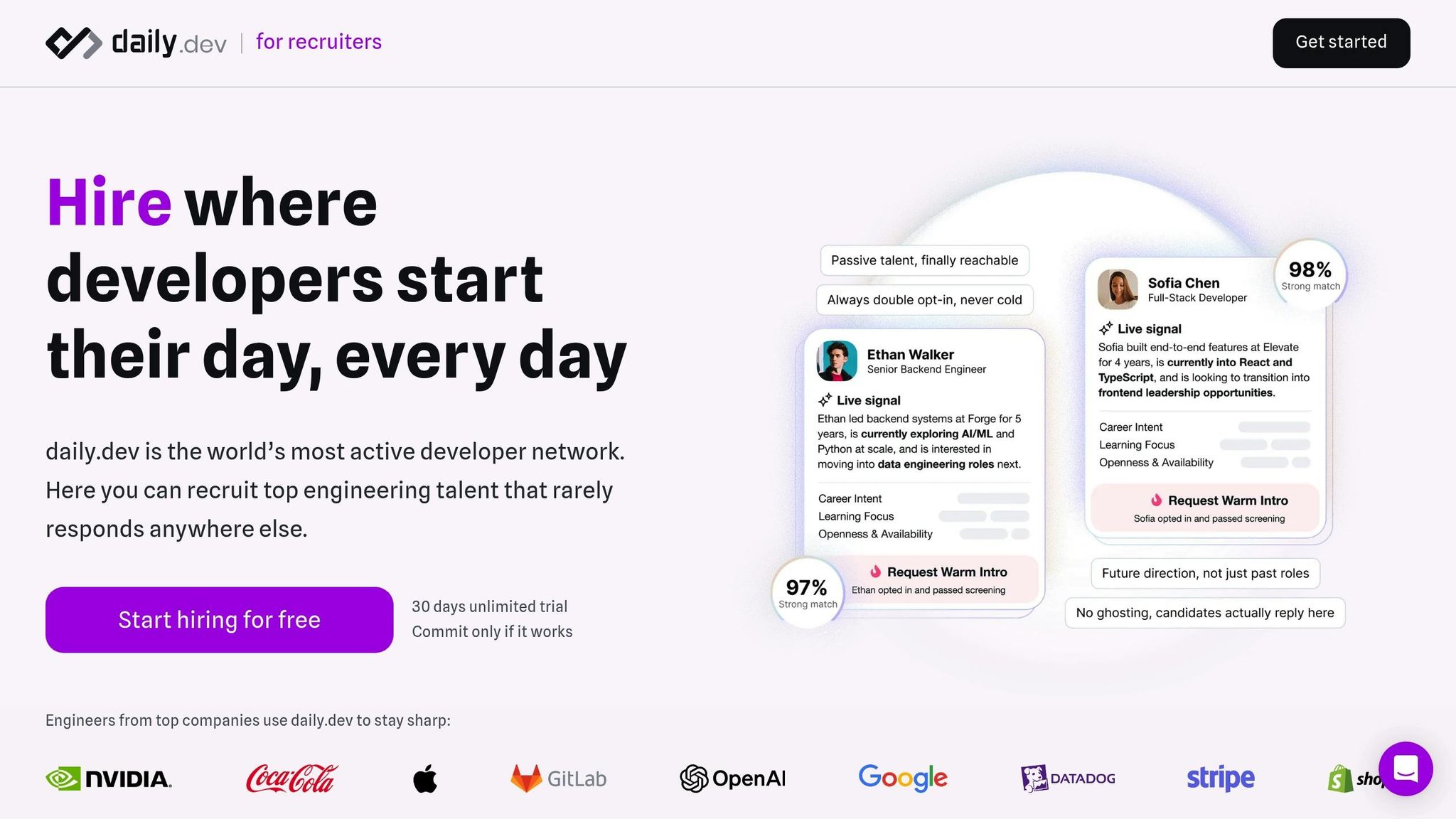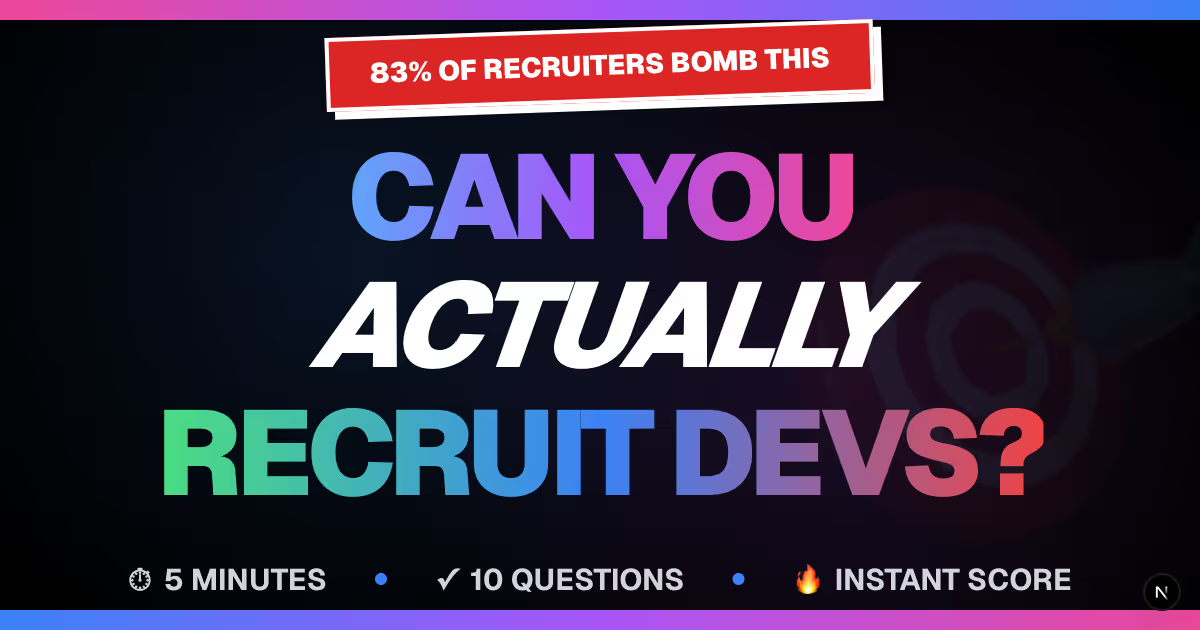


Explore the differences between ATS integration and manual recruitment processes, and discover which approach best suits your hiring needs.
Recruitment boils down to two main approaches: ATS integration or manual processes. ATS (Applicant Tracking System) automates tasks like candidate sourcing, data entry, and screening, offering speed and efficiency. Manual methods rely on personal outreach and human judgment, excelling in niche or specialized roles. Here's the core takeaway:
- ATS Integration: Ideal for high-volume hiring, global reach, and reducing repetitive tasks. Reply rates can hit 85–90% with warm, personalized introductions.
- Manual Processes: Best for roles requiring deep relationship-building or a personal touch, but struggles with scalability and speed.
Quick Comparison
| Factor | ATS Integration | Manual Methods |
|---|---|---|
| Speed | Automates repetitive tasks, faster hiring | Slower due to individual outreach |
| Scalability | Handles large volumes globally | Limited by resources and manual effort |
| Accuracy | Reduces errors, avoids duplicate contacts | Prone to mistakes with manual data entry |
| Candidate Experience | Personalized, context-driven introductions | Often impersonal, relies on cold outreach |
| Response Rates | Higher (85–90%) with trusted connections | Lower, especially with cold outreach |
Key Insight: Use ATS for efficiency and scale. Use manual methods for precision and personal interaction. A hybrid approach often delivers the best results.
PART 1: What is an Applicant Tracking System (ATS) & How to create a MANUAL ATS
ATS Integration: Core Functions and Benefits
ATS integration brings together essential tasks like candidate sourcing, screening, and data entry into a single, streamlined process. This creates opportunities for automation, better insights, and improved candidate engagement.
Automation and Speed
One standout advantage of ATS integration is its ability to handle repetitive tasks automatically. For example, it can deduplicate candidate profiles, preventing recruiters from reaching out to the same person multiple times. This ensures that efforts are focused on engaging with new and relevant talent. Additionally, automated data transfers keep candidate profiles fresh and complete, saving time and reducing manual errors.
The integration also speeds up the hiring process. Warm introductions - where candidates are approached with personalized, context-driven messages - see reply rates of 85–90% in early stages. This means recruiters can spend less time waiting for responses and more time building meaningful connections.
Data-Driven Insights
Data is another key strength of ATS integration. It enhances hiring decisions by enriching your existing ATS data with fresh insights. For example, it can reveal a developer's technical interests, learning habits, and career progression - details that often don’t appear on a traditional resume. Custom screening questions can also be integrated directly into the workflow, with candidate responses automatically synced to the ATS. This approach ensures candidates are evaluated against specific criteria while also broadening your reach to include passive talent who might not actively apply through job boards.
Improved Candidate Experience
ATS integration doesn’t just benefit recruiters - it also elevates the candidate experience. Instead of bombarding developers with generic job postings, it delivers tailored opportunities that align with their skills and career aspirations. Through warm introductions, candidates are immediately given the context of the role, helping them determine if it’s a good fit. This clarity reduces mismatches and eliminates unnecessary screening calls.
In the competitive developer market, where 90% of the daily.dev network won’t respond to traditional outreach, providing personalized and meaningful interactions is crucial. By leveraging these tailored introductions, companies can quickly connect with talented individuals who are already part of a trusted network.
Manual Recruitment: Features and Limitations
Manual recruitment relies on personal outreach and human judgment to connect with candidates. This method emphasizes one-on-one interactions, allowing recruiters to craft tailored messages and adapt their timing to suit individual circumstances. The flexibility of this approach helps build stronger personal connections, as recruiters can adjust their communication style based on the unique needs of each candidate.
When Manual Methods Work Best
Manual recruitment shines in situations where quality and precision matter more than quantity. For example, it’s ideal for filling specialized roles like executive positions or niche technical jobs, where finding the right fit is critical. In startups, founders often take a hands-on role in hiring to ensure new team members align with the company’s values and dynamic. Similarly, when hiring for roles that depend on personal networks or require localized knowledge, manual methods offer the advantage of a more customized evaluation process compared to automated systems.
Manual Recruitment Drawbacks
While manual recruitment offers a personal touch, it struggles to keep up with the demands of scaling. The process of reaching out to candidates individually is time-intensive and can create significant bottlenecks when hiring needs increase.
Scalability is a major hurdle. Manual methods often fall short in connecting with a global pool of talent, particularly passive candidates who aren’t actively applying on job boards. Without automation, recruiters may inadvertently contact the same candidates multiple times, leading to frustration and wasted effort. Additionally, manual data entry increases the risk of errors and adds to administrative workloads. The lack of systematic data collection also makes it harder to analyze trends or extract meaningful insights from the recruitment process.
"Most platforms give you a database of profiles. With daily.dev, you get warm, double opt-in introductions from developers already engaged on our platform. It's a distribution channel powered by developer attention, not another search tool."
These limitations highlight why many organizations are turning to hybrid approaches that combine the personal connection of manual recruitment with the efficiency and scalability of automation. This balance is essential, as explored further in the upcoming best practices for developer recruitment.
sbb-itb-d1e6221
Side-by-Side Comparison: ATS vs Manual Methods
When it comes to hiring developers who appreciate clear and personalized opportunities, comparing ATS integration with manual recruitment sheds light on which approach works best for different hiring needs. Let’s break it down.
Comparison Table: Main Differences
| Factor | ATS Integration | Manual Methods |
|---|---|---|
| Speed | Automated matching and screening speed up candidate flow | Slower due to individual outreach and screening |
| Scalability | Designed to handle large volumes of candidates globally | Limited by manual effort and available resources |
| Accuracy | Automated processes reduce errors and avoid duplicates | Manual entry increases the risk of mistakes and redundancy |
| Candidate Experience | Warm, double opt-in introductions with detailed context | Often impersonal cold outreach with minimal customization |
| Response Rates | High reply rates (85–90%) due to trusted connections | Lower response rates typical of cold outreach |
| Data Management | Candidate data flows directly into ATS systems automatically | Relies on manual data entry, slowing processes |
| Global Reach | Provides instant access to a worldwide talent pool | Limited to the recruiter’s personal network and efforts |
The table outlines the key differences, but let’s dive deeper into the strengths and weaknesses of each method.
Pros and Cons of Each Method
ATS Integration has clear advantages when it comes to speed and efficiency. By automating processes like matching and screening, platforms such as daily.dev Recruiter connect recruiters with a vast global network - reaching 1 in 50 developers worldwide and driving impressive engagement. This approach works especially well for high-volume hiring, where trust-based connections and automation streamline the process.
However, one downside of ATS integration is that it can feel less personal during the initial stages of communication. Despite this, the benefits of efficiency and quality matches often outweigh the lack of a personal touch, particularly in developer-focused recruitment.
On the other hand, Manual Recruitment thrives on its ability to create personalized outreach and foster deeper relationships. This approach is ideal for building trust and tailoring opportunities to individual candidates. But as hiring needs grow, manual methods face challenges. The process becomes slower, prone to errors, and less effective - especially with developer audiences, where cold outreach struggles to gain traction. Manual data entry also introduces inefficiencies, creating bottlenecks and increasing the risk of duplicate contacts.
"When an intro happens, all the info flows straight into your ATS. No manual entry."
Given these contrasts, many organizations find success with a hybrid approach. By combining the efficiency of ATS integration for sourcing and initial screening with selective manual outreach to nurture relationships, companies can strike a balance that meets both volume and personalization needs.
Best Practices for Developer Recruitment
Deciding between ATS integration and manual recruitment methods can have a big impact on your hiring strategy for developers. The trick is to match your approach to factors like hiring volume, the complexity of the roles, and the type of candidate experience you aim to provide.
When to Use ATS Integration
Automated systems like ATS (Applicant Tracking System) are a go-to solution when dealing with large-scale hiring or when it's crucial to standardize your recruitment process. If your hiring involves multiple team members or requires consistent screening and tracking, ATS integration ensures no candidate is overlooked. Plus, it provides valuable analytics to track metrics such as time-to-hire, source effectiveness, and candidate conversion rates. For companies sourcing talent globally, ATS tools simplify the process of matching candidates and maintaining communication. This kind of automation is especially helpful for managing high volumes, in contrast to the more tailored approach of manual recruitment.
When Manual Methods Work Better
Manual recruitment shines when you're hiring for specialized or niche roles that require a deeper level of technical understanding and personalized interaction. For executive positions or senior technical leadership roles, where relationship-building and assessing alignment with team dynamics are critical, a hands-on approach often works best. Smaller companies with fewer hiring needs - or roles that call for detailed candidate evaluations - may also find manual methods more suitable. Platforms like daily.dev Recruiter combine both approaches to optimize results for developer hiring.
Using daily.dev Recruiter for Developer Hiring

Balancing speed and personalization is key, and daily.dev Recruiter is designed to do just that. The platform combines ATS automation with personalized outreach by syncing seamlessly with your existing ATS. It automatically updates candidate information, giving you access to a large, engaged talent pool. Additionally, custom screening questions help pinpoint essential qualifications that might not be fully captured in a typical job description. This ensures a blend of automated efficiency and thorough candidate evaluation.
For those trying out daily.dev Recruiter, the platform offers a risk-free 30-day free trial with unlimited job postings and seats, making it easy to assess its value. Its pay-per-job pricing model ensures you only spend when actively hiring, keeping costs manageable. On top of that, built-in deduplication features prevent repeated outreach to the same candidates, simplifying your recruitment process and enhancing your existing tools without unnecessary complications.
Conclusion: Choosing the Right Recruitment Method
Deciding between ATS integration and manual recruitment ultimately depends on your hiring needs and overall business goals. Matching the right approach to your specific situation can make a big difference in the success of your recruitment efforts.
ATS integration is a go-to option when you need to scale hiring efficiently, ensure consistency across multiple roles, and tap into larger talent pools. Its automation features take care of repetitive tasks and provide actionable data insights to fine-tune your hiring strategies over time. On the other hand, manual recruitment shines when you need to focus on personalized connections, assess candidates for niche roles, or prioritize relationship-building as a key part of the decision-making process.
Using a combination of both strategies can give you the best of both worlds. A hybrid approach balances the speed and efficiency of automation with the personal touch that builds trust and engagement. For example, pairing automated candidate matching with warm, personalized introductions can deliver strong results. In fact, double opt-in introductions often achieve reply rates of 85–90%, showcasing how technology can complement, rather than replace, the human element in recruitment.
When choosing your strategy, consider factors like the number of hires you need, the complexity of the roles, the size of your team, and the type of candidate experience you want to create. Companies that thrive in today’s competitive talent market are those that stay adaptable, using the right tools for each hiring challenge while maintaining systems that can evolve with their needs.
Whether you lean on automated tools, manual methods, or a mix of both, the goal remains the same: connecting with the right candidates while fostering strong, lasting professional relationships. For developer recruitment, in particular, an approach that prioritizes efficiency without sacrificing trust and meaningful interactions is essential to engaging technical talent who value thoughtful, context-driven opportunities.
FAQs
What are the main benefits of using ATS integration instead of manual recruitment processes?
Using ATS integration can transform the way recruitment is handled compared to traditional manual processes. By automating repetitive tasks like sorting through applications and scheduling interviews, it frees up a significant amount of time for recruiters. This not only speeds up the hiring process but also minimizes the chances of human errors, ensuring smoother data management and tracking every step of the way.
When paired with tools like daily.dev Recruiter, ATS integration becomes even more impactful. It simplifies workflows, making the entire recruitment process easier for both recruiters and candidates. This means you can spend more time connecting with top talent and less time wrestling with administrative hurdles.
When is it best to combine ATS integration with manual recruitment processes?
A mixed strategy that blends ATS integration with manual recruitment can strike the perfect balance when you need both efficiency and a personal touch. On one hand, ATS integration handles tasks like automated initial screenings and smooth candidate tracking, saving time and minimizing mistakes. On the other hand, manual efforts allow recruiters to connect on a deeper level with top candidates, offering personalized interactions.
Using tools like daily.dev Recruiter takes this approach to the next level. By syncing with your ATS, it simplifies managing candidate data while letting you focus your manual efforts on engaging with pre-qualified developers who are genuinely interested in the role. This method ensures a smoother recruitment process without sacrificing the essential human connection.
How can companies provide a personalized candidate experience with ATS integration?
With daily.dev Recruiter, employers can connect with developers in a way that feels personal and engaging. By interacting directly within a developer's professional network, recruiters gain a deeper understanding of each candidate's specific skills, interests, and career aspirations.
This method enables companies to customize their communication and job offerings, ensuring candidates feel genuinely valued and recognized. Instead of relying on generic outreach, daily.dev Recruiter transforms the process into one built on trust and relevance, making each interaction meaningful and tailored to the individual.
Related Blog Posts








